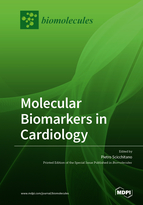Molecular Biomarkers In Cardiology
A special issue of Biomolecules (ISSN 2218-273X). This special issue belongs to the section "Molecular Medicine".
Deadline for manuscript submissions: closed (31 December 2020) | Viewed by 55070
Special Issue Editor
Interests: heart failure; preventive cardiology; vascular biology; endothelial function; cardiovascular pharmacology
Special Issues, Collections and Topics in MDPI journals
Special Issue Information
Dear Colleagues,
Cardiovascular diseases still represent the major cause of death worldwide. The need for preventing the acute onset of such diseases and to predict their occurrence is the major goal of medicine. By succeeding in preventing the negative consequences of cardiovascular diseases, physicians can prevent both mortality and morbidities of the patients. Therefore, the implementation in quality of life and the reduction in the financial burden of health due to the reduced impact of chronic comorbidities related to cardiovascular diseases will also improve the economics of the nations.
The use of biomarkers is the key for conquering the tip of this target-mountain.
Indeed, the ideal biomarkers should be sensitive and specific, able to detect the onset of pathologies early and in time to allow physicians to counteract the exploit of the disease.
Biomolecular approaches for early identification of cardiovascular diseases before their onset are an attractive field in cardiology. There is little evidence about the perfect biomarker able to identify the unstable atherosclerotic plaque, the occurrence of aortic dissection, or the incipient onset of heart failure.
The aim of this Special Issue is to offer the readers the best overview about the current state of knowledge of biomolecular biomarkers in cardiovascular diseases.
Dr. Pietro Scicchitano
Guest Editor
Manuscript Submission Information
Manuscripts should be submitted online at www.mdpi.com by registering and logging in to this website. Once you are registered, click here to go to the submission form. Manuscripts can be submitted until the deadline. All submissions that pass pre-check are peer-reviewed. Accepted papers will be published continuously in the journal (as soon as accepted) and will be listed together on the special issue website. Research articles, review articles as well as short communications are invited. For planned papers, a title and short abstract (about 100 words) can be sent to the Editorial Office for announcement on this website.
Submitted manuscripts should not have been published previously, nor be under consideration for publication elsewhere (except conference proceedings papers). All manuscripts are thoroughly refereed through a single-blind peer-review process. A guide for authors and other relevant information for submission of manuscripts is available on the Instructions for Authors page. Biomolecules is an international peer-reviewed open access monthly journal published by MDPI.
Please visit the Instructions for Authors page before submitting a manuscript. The Article Processing Charge (APC) for publication in this open access journal is 2700 CHF (Swiss Francs). Submitted papers should be well formatted and use good English. Authors may use MDPI's English editing service prior to publication or during author revisions.
Keywords
- Biomolecules
- Biomarkers
- Atherosclerotic plaques instability
- Heart failure
- Prognosis and diagnosis







